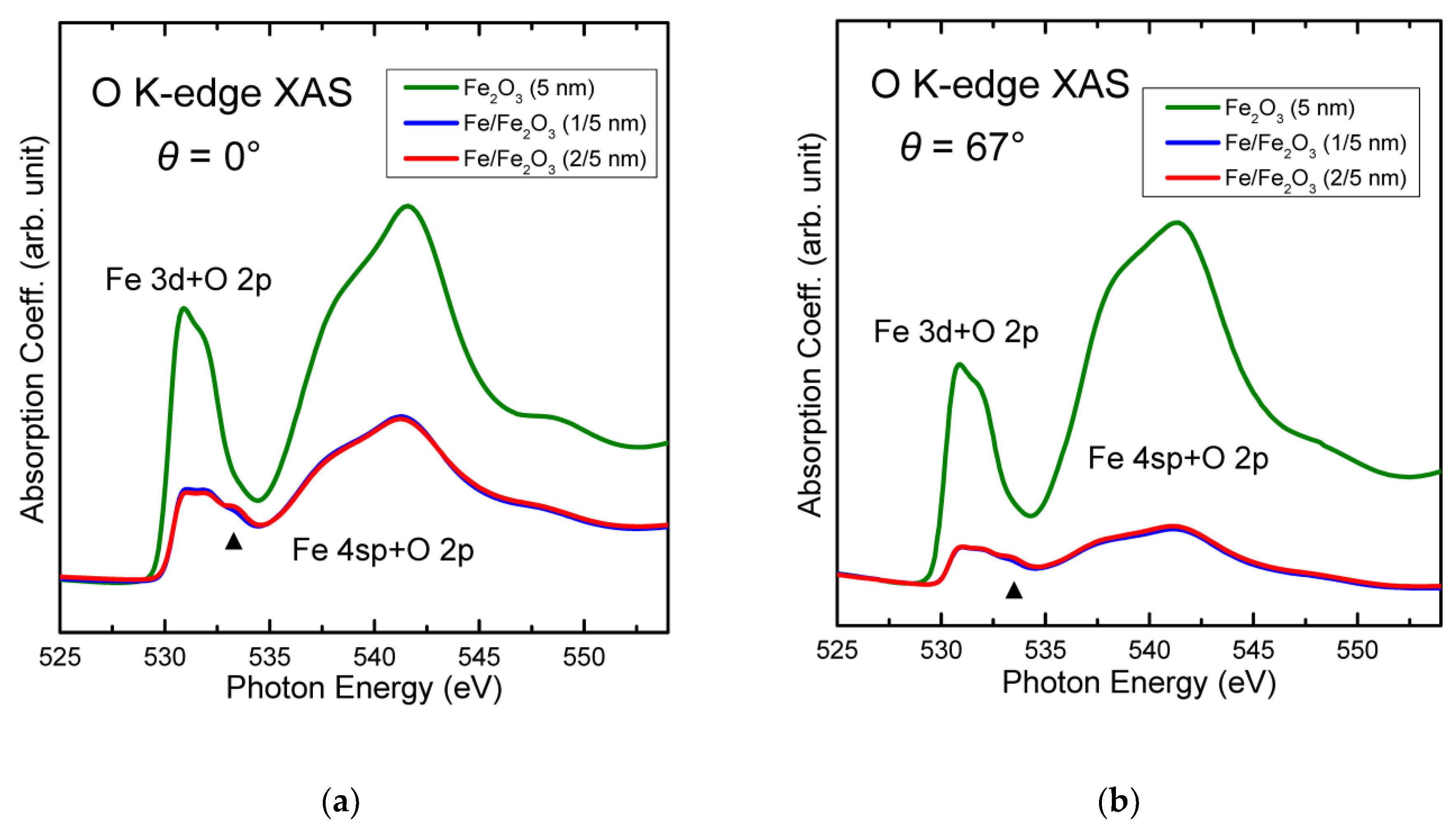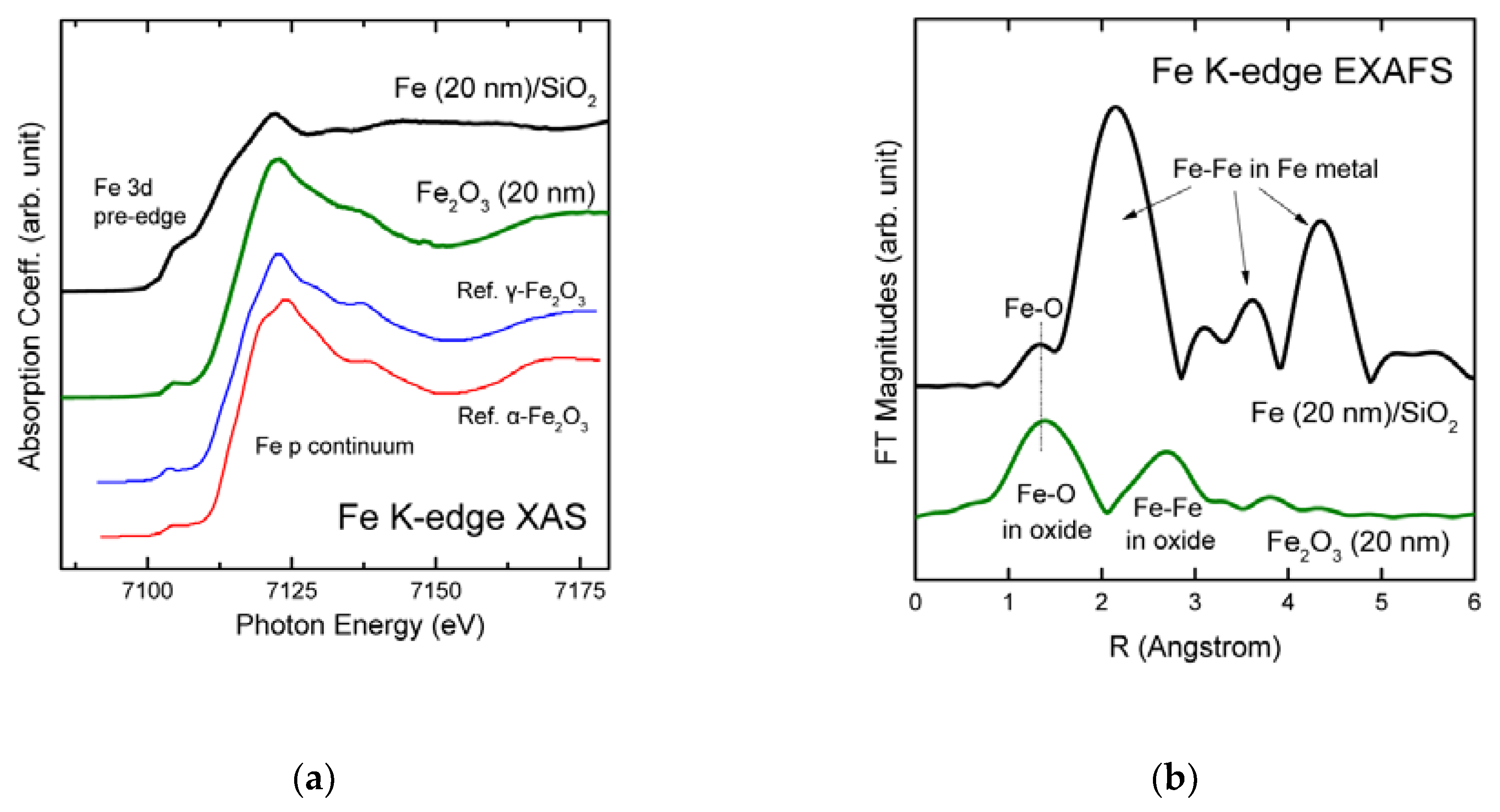Chemical Structure and Magnetism of FeOx/Fe2O3 Interface Studied by X-ray Absorption Spectroscopy
Abstract
1. Introduction
2. Materials and Methods
3. Results
4. Discussion
Author Contributions
Funding
Conflicts of Interest
References
- Khurshid, H.; Phan, M.-H.; Mukherjee, P.; Srikanth, H. Tuning exchange bias in Fe/γ-Fe2O3 core-shell nanoparticles: Impacts of interface and surface spins. Appl. Phys. Lett. 2014, 104, 072407. [Google Scholar] [CrossRef]
- Crisan, O.; von Haeften, K.; Ellis, A.; Binns, C. Structure and magnetic properties of Fe/Fe oxide clusters. J. Nanopart. Res. 2008, 10, 193–199. [Google Scholar] [CrossRef]
- Kaur, M.; McCloy, J.S.; Qiang, Y. Exchange bias in core-shell iron-iron oxide nanoclusters. J. Appl. Phys. 2013, 113, 17D715. [Google Scholar] [CrossRef]
- Signorini, L.; Pasquini, L.; Boscherini, F.; Bonetti, E.; Letard, I.; Brice-Profeta, S.; Sainctavit, P. Local magnetism in granular iron/iron oxide nanostructures by phase-and site-selective x-ray magnetic circular dichroism. Phys. Rev. B 2006, 74, 014426. [Google Scholar] [CrossRef]
- Tang, D.; Wang, P.; Speriosu, V.; Le, S.; Kung, K. Spin-valve RAM cell. IEEE Trans. Magn. 1995, 31, 3206–3208. [Google Scholar] [CrossRef]
- Parkin, S.S.P.; Roche, K.P.; Samant, M.G.; Rice, P.M.; Beyers, R.B.; Scheuerlein, R.E.; O’sullivan, E.J.; Brown, S.L.; Bucchigano, J.; Abraham, D.W.; et al. Exchange-biased magnetic tunnel junctions and application to nonvolatile magnetic random access memory. J. Appl. Phys. 1999, 85, 5828–5833. [Google Scholar] [CrossRef]
- Quindeau, A.; Fina, I.; Marti, X.; Apachitei, G.; Ferrer, P.; Nicklin, C.; Pippel, E.; Hesse, D.; Alexe, M. Four-state ferroelectric spin-valve. Sci. Rep. 2015, 5, 9749. [Google Scholar] [CrossRef]
- Wang, S.; Han, G.; Yu, G.; Jiang, Y.; Wang, C.; Kohn, A.; Ward, R. Evidence for FeO formation at the Fe/MgO interface in epitaxial TMR structure by X-ray photoelectron spectroscopy. J. Magn. Magn. Mater. 2007, 310, 1935–1936. [Google Scholar] [CrossRef]
- Telesca, D.; Sinkovic, B.; Yang, S.-H.; Parkin, S. X-ray studies of interface Fe-oxide in annealed MgO based magnetic tunneling junctions. J. Electron. Spectrosc. Relat. Phenom. 2012, 185, 133–139. [Google Scholar] [CrossRef]
- Lu, Y.; Claydon, J.S.; Ahmad, E.; Xu, Y.; Thompson, S.M.; Wilson, K.; van der Laan, G. XPS and XMCD study of Fe3O4/GaAs interface. IEEE Trans. Magn. 2005, 41, 2808–2810. [Google Scholar] [CrossRef]
- Kim, D.; Lee, H.; Kim, G.; Koo, Y.; Jung., J.; Shin, H.; Kim, J.-Y.; Kang, J.-S. Interface electronic structures of BaTiO3@ X nanoparticles (X= γ-Fe2O3, Fe3O4, α-Fe2O3, and Fe) investigated by XAS and XMCD. Phys. Rev. B 2009, 79, 033402. [Google Scholar] [CrossRef]
- Genuzio, F.; Menteş, T.; Freindl, K.; Spiridis, N.; Korecki, J.; Locatelli, A. Chemistry-dependent magnetic properties at the FeNi oxide–metal interface. J. Mater. Chem. C 2020, 8, 5777–5785. [Google Scholar] [CrossRef]
- Tong, H.; Qian, C.; Miloslavsky, L.; Funada, S.; Shi, X.; Liu, F.; Dey, S. Studies on antiferromagnetic/ferromagnetic interfaces. J. Magn. Magn. Mater. 2000, 209, 56–60. [Google Scholar] [CrossRef]
- Robbennolt, S.; Nicolenco, A.; Mercier Fernandez, P.; Auffret, S.; Baltz, V.; Pellicer, E.; Menéndez, E.; Sort, J. Electric field control of magnetism in iron oxide nanoporous thin films. ACS Appl. Mater. Interfaces 2019, 11, 37338–37346. [Google Scholar] [CrossRef] [PubMed]
- Li, P.; Xia, C.; Zhu, Z.; Wen, Y.; Zhang, Q.; Alshareef, H.N.; Zhang, X.X. Ultrathin Epitaxial Ferromagnetic γ-Fe2O3 Layer as High Efficiency Spin Filtering Materials for Spintronics Device Based on Semiconductors. Adv. Funct. Mater. 2016, 26, 5679–5689. [Google Scholar] [CrossRef]
- Lu, Y.; Claydon, J.; Xu, Y.; Thompson, S.; Wilson, K.; Van der Laan, G. Epitaxial growth and magnetic properties of half-metallic Fe3O4 on GaAs (100). Phys. Rev. B 2004, 70, 233304. [Google Scholar] [CrossRef]
- Lu, Y.; Ahmad, E.; Xu, Y.; Thompson, S.M. Annealing-induced Fe oxide nanostructures on GaAs. IEEE Trans. Magn. 2005, 41, 3328–3330. [Google Scholar] [CrossRef]
- Hassan, S.S.; Xu, Y.; Wu, J.; Thompson, S.M. Epitaxial Growth and Magnetic Properties of Half-Metallic Fe3O4 on Si (100) Using MgO Buffer Layer. IEEE Trans. Magn. 2009, 45, 4357–4359. [Google Scholar] [CrossRef]
- Paul, M.; Müller, A.; Ruff, A.; Schmid, B.; Berner, G.; Mertin, M.; Sing, M.; Claessen, R. Probing the interface of Fe3O4/GaAs thin films by hard x-ray photoelectron spectroscopy. Phys. Rev. B 2009, 79, 233101. [Google Scholar] [CrossRef]
- Nozaki, T.; Kubota, H.; Fukushima, A.; Yuasa, S. Interface engineering using an Fe oxide insertion layer for growing a metastable bcc-Co on MgO (001). Appl. Phys. Lett. 2015, 106, 022405. [Google Scholar] [CrossRef]
- Wong, P.J.; Zhang, W.; Wang, K.; van der Laan, G.; Xu, Y.; van der Wiel, W.G.; de Jong, M.P. Electronic and magnetic structure of C60/Fe3O4 (001): A hybrid interface for organic spintronics. J. Mater. Chem. C 2013, 1, 1197–1202. [Google Scholar] [CrossRef]
- Jiménez-Villacorta, F.; Prieto, C.; Huttel, Y.; Telling, N.; van der Laan, G. X-ray magnetic circular dichroism study of the blocking process in nanostructured iron-iron oxide core-shell systems. Phys. Rev. B 2011, 84, 172404. [Google Scholar] [CrossRef]
- Stöhr, J.; Siegmann, H. Magnetism: From Fundamentals to Nanoscale Dynamics; Springer: Berlin/Heidelberg, Germany, 2006. [Google Scholar]
- Miedema, P.S.; De Groot, F.M. The iron L edges: Fe 2p X-ray absorption and electron energy loss spectroscopy. J. Electron. Spectrosc. Relat. Phenom. 2013, 187, 32–48. [Google Scholar] [CrossRef]
- Pauling, L.; Hendricks, S.B. The crystal structures of hematite and corundum. J. Am. Chem. Soc. 1925, 47, 781–790. [Google Scholar] [CrossRef]
- Schulz, D.L.; McCarthy, G.J. X-ray powder data for an industrial maghemite (γ-Fe2O3). Powder Diffr. 1988, 3, 104–105. [Google Scholar] [CrossRef]
- Lee, E.; Kim, D.; Hwang, J.; Lee, K.; Yoon, S.; Suh, B.; Hyun Kim, K.; Kim, J.-Y.; Jang, Z.; Kim, B.; et al. Size-dependent structural evolution of the biomineralized iron-core nanoparticles in ferritins. Appl. Phys. Lett. 2013, 102, 133703. [Google Scholar] [CrossRef]
- Brice-Profeta, S.; Arrio, M.-A.; Tronc, E.; Menguy, N.; Letard, I.; dit Moulin, C.C.; Nogues, M.; Chanéac, C.; Jolivet, J.-P.; Sainctavit, P. Magnetic order in γ-Fe2O3 nanoparticles: A XMCD study. J. Magn. Magn. Mater. 2005, 288, 354–365. [Google Scholar] [CrossRef]
- Lee, J.-M.; Kim, J.-Y.; Yang, S.-U.; Park, B.-G.; Park, J.-H.; Oh, S.-J.; Kim, J.-S. Magnetism of pristine Fe films on GaAs (100). Phys. Rev. B 2007, 76, 052406. [Google Scholar] [CrossRef]
- Radaelli, G.; Petti, D.; Plekhanov, E.; Fina, I.; Torelli, P.; Salles, B.; Cantoni, M.; Rinaldi, C.; Gutiérrez, D.; Panaccione, G.; et al. Electric control of magnetism at the Fe/BaTiO3 interface. Nat. Commun. 2014, 5, 1–9. [Google Scholar] [CrossRef]
- Cao, L.; Jiang, Z.-X.; Du, Y.-H.; Yin, X.-M.; Xi, S.-B.; Wen, W.; Roberts, A.P.; Wee, A.T.; Xiong, Y.-M.; Liu, Q.-S.; et al. Origin of magnetism in hydrothermally aged 2-line ferrihydrite suspensions. Environ. Sci. Technol. 2017, 51, 2643–2651. [Google Scholar] [CrossRef]
- Pollak, M.; Gautier, M.; Thromat, N.; Gota, S.; Mackrodt, W.; Saunders, V. An in-situ study of the surface phase transitions of α-Fe2O3 by X-ray absorption spectroscopy at the oxygen K edge. Nucl. Instrum. Methods Phys. Res. B 1995, 97, 383–386. [Google Scholar] [CrossRef]
- Trainor, T.P.; Templeton, A.S.; Eng, P.J. Structure and reactivity of environmental interfaces: Application of grazing angle X-ray spectroscopy and long-period X-ray standing waves. J. Electron. Spectrosc. Relat. Phenom. 2006, 150, 66–85. [Google Scholar] [CrossRef]
- Bora, D.K.; Braun, A.; Erat, S.; Ariffin, A.K.; Löhnert, R.; Sivula, K.; Töpfer, J.; Grätzel, M.; Manzke, R.; Graule, T.; et al. Evolution of an oxygen near-edge X-ray absorption fine structure transition in the upper Hubbard band in α-Fe2O3 upon electrochemical oxidation. J. Phys. Chem. C 2011, 115, 5619–5625. [Google Scholar] [CrossRef][Green Version]
- Yang, C.K.; Chiou, J.W.; Tsai, H.M.; Pao, C.W.; Jan, J.C.; Ray, S.C.; Yeh, C.L.; Huang, K.C.; Hsueh, H.C.; Pong, W.F.; et al. Electronic structure and magnetic properties of Al-doped Fe3O4 films studied by X-ray absorption and magnetic circular dichroism. Appl. Phys. Lett. 2005, 86, 062504. [Google Scholar] [CrossRef]
- Chen, C.L.; Dong, C.L.; Rao, S.M.; Chern, G.; Chen, M.C.; Wu, M.K.; Chang, C.L. Investigation of the valence states of Fe and Co in Fe1−xCoxOy (0 < x < 1) thin films by x-ray absorption spectroscopy. J. Condens. Matter Phys. 2008, 20, 255236. [Google Scholar] [CrossRef]
- Kumar, S.; Kumar, R.; Thakur, P.; Chae, K.H.; Sharma, S.K. Electronic structure studies of Mg0. 95Mn0. 05Fe2−2xTi2xO4 (0 ⩽ x ⩽ 0.8). J. Magn. Magn. Mater. 2008, 320, e121–e124. [Google Scholar] [CrossRef]
- Shen, S.; Zhou, J.; Dong, C.-L.; Hu, Y.; Tseng, E.N.; Guo, P.; Guo, L.; Mao, S.S. Surface engineered doping of hematite nanorod arrays for improved photoelectrochemical water splitting. Sci. Rep. 2014, 4, 6627. [Google Scholar] [CrossRef]
- Gautam, S.; Kane, S.N.; Park, B.G.; Kim, J.Y.; Varga, L.; Song, J.H.; Chae, K.H. XAS and XMCD studies of amorphous FeCo-based ribbons. J. Non Cryst. Solids 2011, 357, 2228–2231. [Google Scholar] [CrossRef]
- Miyokawa, K.; Saito, S.; Katayama, T.; Saito, T.; Kamino, T.; Hanashima, K.; Suzuki, Y.; Mamiya, K.; Koide, T.; Yuasa, S. X-ray absorption and X-ray magnetic circular dichroism studies of a monatomic Fe (001) layer facing a single-crystalline MgO (001) tunnel barrier. Jpn. J. Appl. Phys. 2004, 44, L9–L11. [Google Scholar] [CrossRef]
- Xu, M.; Li, M.; Khanal, P.; Habiboglu, A.; Insana, B.; Xiong, Y.; Peterson, T.; Myers, J.C.; Ortega, D.; Qu, H.; et al. Voltage-Controlled Antiferromagnetism in Magnetic Tunnel Junctions. Phys. Rev. Lett. 2020, 124, 187701. [Google Scholar] [CrossRef]
- Pellegrain, E.; Hagelstein, M.; Doyle, S.; Moser, H.; Fuchs, J.; Vollath, D.; Schuppler, S.; James, M.; Saxena, S.; Niesen, L.; et al. Characterization of Nanocrystalline γ-Fe2O3 with Synchrotron Radiation Techniques. Phys. Status Solidi B 1999, 215, 797–801. [Google Scholar] [CrossRef]
- Olimov, K.; Falk, M.; Buse, K.; Woike, T.; Hormes, J.; Modrow, H. X-ray absorption near edge spectroscopy investigations of valency and lattice occupation site of Fe in highly iron-doped lithium niobate crystals. J. Condens. Matter Phys. 2006, 18, 5135. [Google Scholar] [CrossRef]
- Bora, D.K.; Braun, A.; Erat, S.; Safonova, O.; Graule, T.; Constable, E.C. Evolution of structural properties of iron oxide nano particles during temperature treatment from 250 oC–900 oC: X-ray diffraction and Fe K-shell pre-edge X-ray absorption study. Curr. Appl. Phys. 2012, 12, 817–825. [Google Scholar] [CrossRef]
- Sanson, A. Comment on ‘On the discrimination between magnetite and maghemite by XANES measurements in fluorescence mode’. Meas. Sci. Technol. 2013, 24, 118001. [Google Scholar] [CrossRef]
- Ravel, B.; Newville, M. ATHENA, ARTEMIS, HEPHAESTUS: Data analysis for X-ray absorption spectroscopy using IFEFFIT. J. Synchrotron Radiat. 2005, 12, 537–541. [Google Scholar] [CrossRef]
- Stöhr, J. Exploring the microscopic origin of magnetic anisotropies with X-ray magnetic circular dichroism (XMCD) spectroscopy. J. Magn. Magn. Mater. 1999, 200, 470–497. [Google Scholar] [CrossRef]
- Kim, W.; Choi, J.H.; Nahm, T.U.; Song, S.H.; Oh, S.J. Magnetic properties of ultrathin Fe films on Pt (111) and Pd (111): A surface magneto-optic Kerr effect study. J. Korean Phys. Soc. 2004, 44, 722–725. [Google Scholar]





© 2020 by the authors. Licensee MDPI, Basel, Switzerland. This article is an open access article distributed under the terms and conditions of the Creative Commons Attribution (CC BY) license (http://creativecommons.org/licenses/by/4.0/).
Share and Cite
Mohamed, A.Y.; Park, W.G.; Cho, D.-Y. Chemical Structure and Magnetism of FeOx/Fe2O3 Interface Studied by X-ray Absorption Spectroscopy. Magnetochemistry 2020, 6, 33. https://doi.org/10.3390/magnetochemistry6030033
Mohamed AY, Park WG, Cho D-Y. Chemical Structure and Magnetism of FeOx/Fe2O3 Interface Studied by X-ray Absorption Spectroscopy. Magnetochemistry. 2020; 6(3):33. https://doi.org/10.3390/magnetochemistry6030033
Chicago/Turabian StyleMohamed, Ahmed Yousef, Won Goo Park, and Deok-Yong Cho. 2020. "Chemical Structure and Magnetism of FeOx/Fe2O3 Interface Studied by X-ray Absorption Spectroscopy" Magnetochemistry 6, no. 3: 33. https://doi.org/10.3390/magnetochemistry6030033
APA StyleMohamed, A. Y., Park, W. G., & Cho, D.-Y. (2020). Chemical Structure and Magnetism of FeOx/Fe2O3 Interface Studied by X-ray Absorption Spectroscopy. Magnetochemistry, 6(3), 33. https://doi.org/10.3390/magnetochemistry6030033




